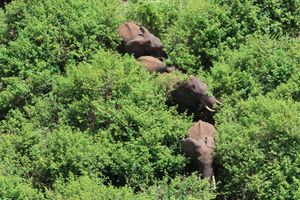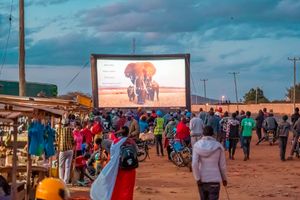Elephants face extinction risk amid shrinking wildlife corridors

Elephants graze at the Amboseli National Park in Kajiado County, Kenya, April 4, 2024.
What you need to know:
- The biodiversity-rich landscape surrounding the Amboseli National Park and the adjoining Mt. Kilimanjaro form a critical corridor for elephants, rhinos, lions, hippos and giraffes.
- The elephants in Amboseli play a critical role of balancing the larger ecosystem and boosting the survival of other wildlife species. Elephants have consistently used southern corridors as they connect with others on the northern slopes of Kilimanjaro.
Conservationists have raised concerns over the future of elephants as their habitats are being disrupted by human encroachment, leading to a diminishing natural corridor and endangering the animals.
Benson Leyian, the CEO of The Big Life Foundation — a non-profit organisation dedicated to the conservation of East Africa's wildlife and ecosystems— emphasises that continued human intrusion has led to the loss of elephants’ habitats and corridors, threatening their survival.
"The failure to urgently secure the corridors encroached by humans around Amboseli National Park spells doom to the future conservation of wildlife species in the entire ecosystem," he said.
A wildlife corridor is an open area of land that connects areas set aside for wildlife protection. Some wildlife species, especially elephants, cannot survive without being able to migrate between nature reserves.
Mr Leyian cited the imminent closure of Nairrabala, a vital wildlife corridor adjacent to Amboseli National Park. The corridor serves as a migratory route for elephants that traverse the landscape. Nairrabala Conservancy, established in 2023, covers over 37,500 acres and consists of 1,780 individual plots of newly subdivided land.
The corridor now faces the threat of closure due to recent shift in land tenure from communal to private ownership.
The transfer of ownership of several former Maasai Group Ranches has resulted in uncontrolled fragmentation of wildlife corridors around the park. Local communities have been selling their land to urban dwellers, threatening the survival of various animals including elephants, giraffes, hippos, cheetahs and rhinoceroses.
Human activities across various national parks have resulted in destruction of plants and animal habitats, exacerbating conflicts between humans and wildlife.
Experts say the eco-tourism industry risks collapsing due to the conversion of wildlife habitats into human settlements or farmlands.
Many local communities have misunderstood the Community Land Act of 2016 and they are now converting communal land into private property.
Some members of the Nairrabala Conservancy community, which has more than 4,000 residents, have sold their parcels of land to buyers in cities such as Nairobi. Others have fenced off their pieces of land to stop animals or people from gaining entry.
Conservationists are worried that if urban development is not managed, it could result lead to extinction of wildlife species.
To address this, organisations such as Big Life Foundation work with local communities to protect wildlife areas such as land around Amboseli National Park.
Big Life pays participating local communities annual leases to keep their land unfenced and unfarmed in Nairrabala.
It also sponsors 72 community health promoters to serve in the Amboseli villages.
"Over the past several decades, pastoralists have been key in the survival of the Amboseli ecosystem as they grazed their livestock freely among wildlife on the vast communal land," said Mr Njoroke ole Sitonik, Nairrabala chairperson.
However, with land subdivisions, the future of wildlife conservation continues to worry conservationists.
They say increased encroachment into the corridors, especially in the highlands that fortified the park's wildlife habitats, should alarm the government.
The biodiversity-rich landscape surrounding the Amboseli National Park and the adjoining Mt. Kilimanjaro form a critical corridor for elephants, rhinos, lions, hippos and giraffes.
The elephants in Amboseli play a critical role of balancing the larger ecosystem and boosting the survival of other wildlife species. Elephants have consistently used southern corridors as they connect with others on the northern slopes of Kilimanjaro.
According to the International Union for Conservation of Nature (IUCN), Amboseli is one of the 62 crucial global bird areas and a member of Unesco's global network of biosphere reserves.
It has at least 503 bird species, with 17 earmarked for the IUCN's Red List. Amboseli is home to more than 1,600 elephants that roam freely in the ecosystem. The Greater Amboseli Ecosystem includes at least a 39,200-hectare national park, is home to elephants and other wildlife, and is one of Africa's most filmed or photographed landscapes.
It has at least seven ranches belonging to the Maasai community, spanning at least 1506,329 hectares.
In 2019, KIliAVo Fresh Limited sought to establish a water-intensive commercial farm that would obstruct the wildlife corridor adjacent to Amboseli.
However, the company's licence was later revoked by the National Environment Tribunal, which said the project posed major ecological threats in the semi-arid region. KiliAvo has appealed that ruling.
A similar case has been reported in Northern Kenya following the establishment of a Kenya Defence Force (KDF) base in an elephant corridor in Karare, Marsabit County.
The KDF reportedly acquired a portion of the Rendille community land held in trust by Marsabit County government.
The military base is also said to have been established on Rendille community's sacred sites, thus violating the community's right to worship.





